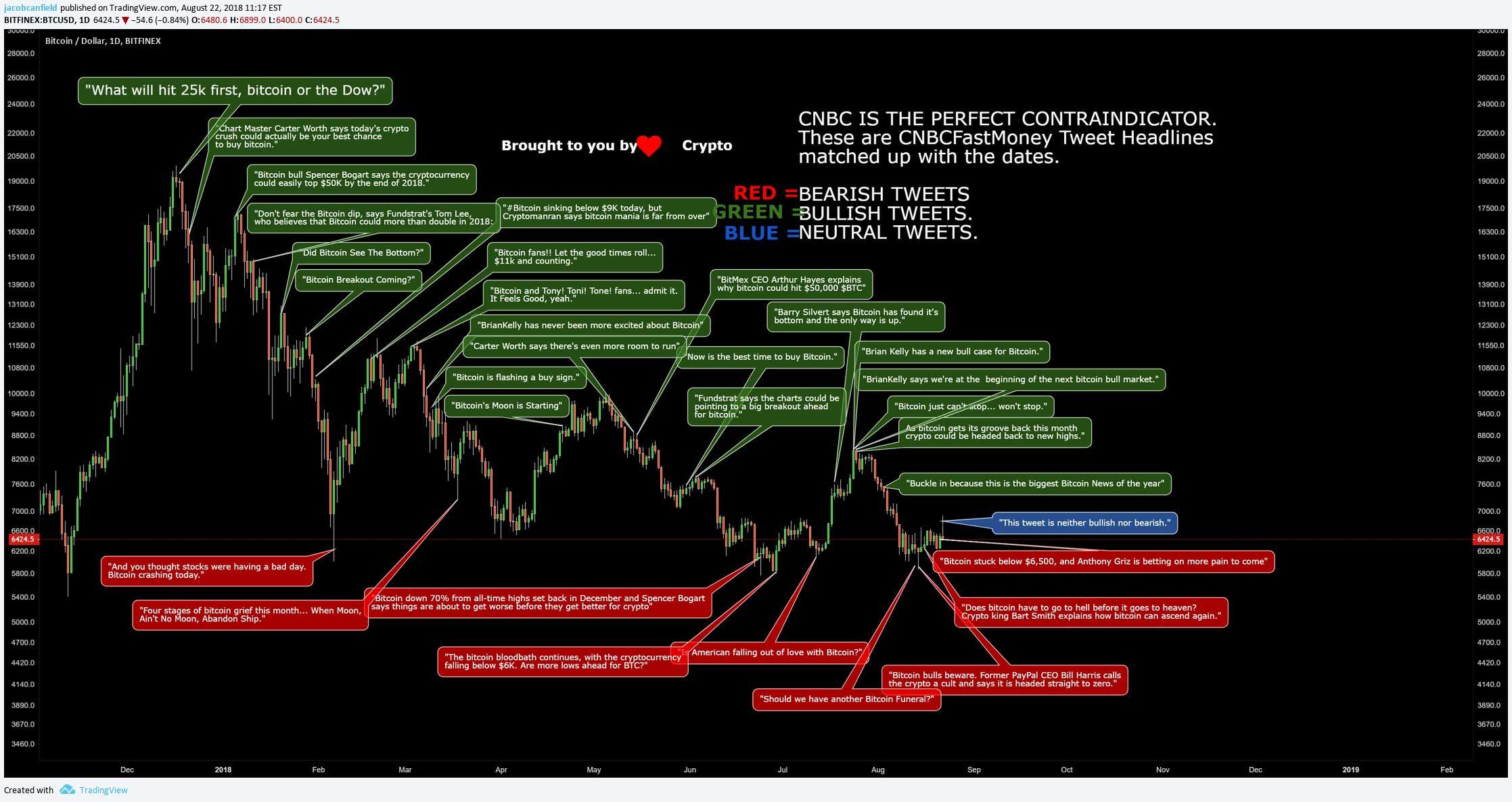The CNBC Fast Money Counter Indicator

The CNBC Fast Money Crypto Indicator
Cryptocurrency traders have decided CNBC Fast Money’s Twitter calls work as a counter indicator. Meaning if the tweet is bullish, go short, and if the tweet is bearish, go long.
For example, see this popular TradingView post or see the Tweet below (BTC dropped to $6,100 in a flash crash a day after this):
NEW TRADE!!
-Short #BTC @ 6319.5
-Trigger: Bullish prediction by #CNBCThis one is risky guys, are we having faith? ? pic.twitter.com/nlnaD3rTmC
— CNBCIndicator (@IndicatorCnbc) September 18, 2018
That said, although the counter indicator is a thing (hence writing an informational article about it), although it is funny, and although the success rate has been oddly high… the whole thing is also essentially a meme.
Let’s address why I consider it a meme, and then I’ll talk a bit more about how to use the indicator. It is a meme because:
- It is generally poking fun at CNBC’s Fast Money… because people give people grief on the internet, especially on Crypto Twitter. They are the one mainstream entity who has a real focus on crypto, so Crypto Twitter gives them grief. Simple.
- It is sort of unfairly giving CNBC Fast Money grief, as it is expecting them to be something they are not. One aspect of the show is discussing whatever new hot asset is making longs or shorts “fast money.” If Bitcoin is flying to the moon (as it historically has enough times), Bitcoin gets a segment on TV and a tweet. If Bitcoin crashes back down after that (also common), Bitcoin gets a segment and a tweet. If XRP won’t stop making gains, you get a “how to buy Ripple.” If XRP is in a deadly downtrend, you get a “how to sell Ripple.” If Tilray goes up 100% in a day, you get Tilray Tweets… thing is, in the most speculative of markets, on the hottest asset of the moment, the clocks are generally ticking. If you watch CNBC they will always have someone on warning the obvious… but when it comes to Twitter, you are also bound to get the bullish click bait calls too. The bottom line being, reporting anything positive on a massive upward movement generally means “calling the top” and reporting on anything negative on a massive downward movement generally means calling a local bottom, and thus the bullish or bearish tweet after a big move often works as a counter indicator.
- It is sort of misunderstanding crypto markets. The whole thing with crypto in most of its phases is that it goes up quickly after going down and goes down quickly after going up. Look at the BTC’s 2018 chart + tweets. Bitcoin has almost never just gone up for the whole of 2018, but likewise, it hasn’t just gone down either. If you just report on the direction it is currently moving and suggest a trade, it will almost always make you look like you are making the wrong call at some point in the near future!
In words, until we break out of the bear market of 2018: if you call up and discuss Bitcoin as bullish when it goes up, you’ll eat your words 8 out of 10 times, and if you call down and discuss Bitcoin as bearish when it goes down, you’ll eat your words just as often.
CNBC Fast Money is informational, but it is also entertainment. They discuss moves when they happen. On the show you get to hear sober opinions from both sides, on Twitter you get the Tweets. The ramp up in coverage happens before trend reversals in part because that is when crypto is exciting again and people are interested… and because CBNC Fast Money is reporting on that, they have spent a lot of 2018 working as a counter indicator.
With all that covered, to use CNBC Fast Money as an indicator: short when they say go long and long when they say go short. You can use their profit taking area to define your stop and their stop to define your profit taking area if it is given. If not, then you have to use some TA skills to find your targets.
That isn’t investment advice. That is how the meme works. See that Tweet above for an example of how it is done. 🙂
